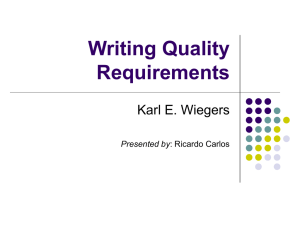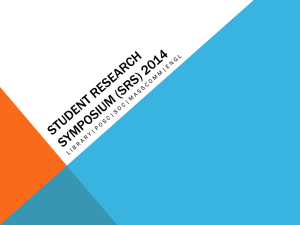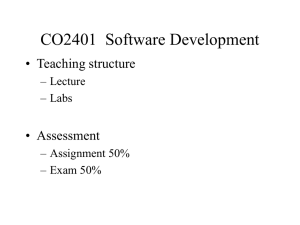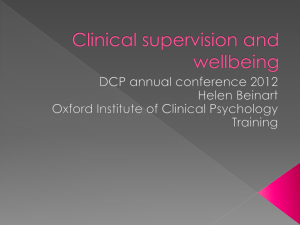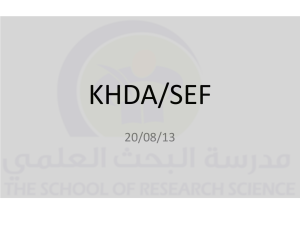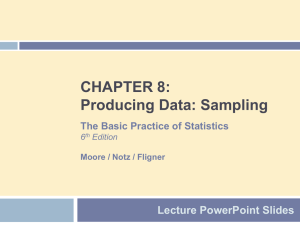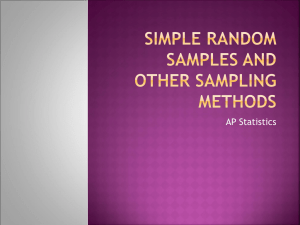SRS - Rose
advertisement
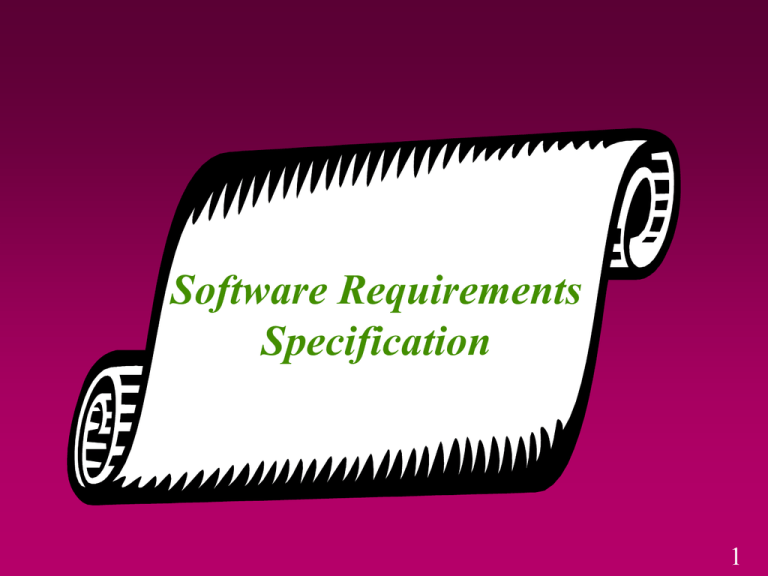
Software Requirements Specification 1 Software Requirements Specification: A Contract Document Requirements document is a reference document. SRS document is a contract between the development team and the customer. – Once the SRS document is approved by the customer, • any subsequent controversies are settled by referring the SRS document. 2 SW Requirements Specification Purpose of SRS – communication between the Customer, Analyst, system developers, maintainers, ... – contract between Purchaser and Supplier – firm foundation for the design phase – support system testing activities – support project management and control – controlling the evolution of the system 3 SRS Document (CONT.) The SRS document is known as black-box specification: – the system is considered as a black box whose internal details are not known. – only its visible external (i.e. input/output) behavior is documented. Input Data S Output Data 4 SRS Document (CONT.) SRS document concentrates on: – what needs to be done – carefully avoids the solution (“how to do”) aspects. The SRS document serves as a contract – between development team and the customer. – Should be carefully written 5 SRS Document (CONT.) The requirements at this stage: – written using end-user terminology. If necessary: – later a formal requirement specification may be developed from it. 6 Software Requirements Specification (SRS) Defines – – – – the customer’s requirements in terms of : Function Performance External interfaces Design constraints The SRS is the basis of contract between the purchaser and supplier 7 Specification Principles Separate functionality from implementation Develop model of desired behavior of the system Establish the context in which s/w operates Define the environment in which system operates Create a cognitive model Specifications must be tolerant of incompleteness & augmentable Content & structure of a specifications should be amenable to change 8 What is not included in an SRS ? Project requirements – cost, delivery schedules, staffing, reporting procedures Design solutions – partitioning of SW into modules, choosing data structures Product assurance plans – Quality Assurance procedures, Configuration Management procedures, Verification & Validation procedures 9 Benefits of SRS Forces the users to consider their specific requirements carefully Enhances communication between the Purchaser and System developers Provides a firm foundation for the system design phase Enables planning of validation, verification, and acceptance procedures Enables project planning eg. estimates of cost and time, resource scheduling Usable during maintenance phase 10 Types of Requirements Functional requirements Non functional requirements – – – – Performance requirements Interface requirements Design constraints Other requirements 11 Functional Requirements Transformations (inputs, processing, outputs) Requirements for sequencing and parallelism (dynamic requirements) Data – Inputs and Outputs – Stored data – Transient data Exception handling Nature of function: Mandatory/ Desirable/ Optional / Volatile / Stable 12 Performance Requirements Capacity – no. of simultaneous users, processing requirements for normal and peak loads, static storage capacity, spare capacity Response time System priorities for users and functions System efficiency Availability Fault recovery All these requirements should be stated in measurable terms so that they can be verified. 13 Verifiable A requirement is verifiable if and only if there exists some finite cost effective process with which a person or machine can check that the SW meets the requirement. 14 External Interface Requirements User interfaces – eg. if display terminal used, specify required screen formats, menus, report layouts, function keys Hardware interfaces – characteristics of the interface between the SW product and HW components of the system Software interfaces – specify the use of other SW products eg. OS, DBMS, other SW packages 15 Design Constraints SW design constraints – standards for design, coding, naming, etc. – SW interfaces (to OS, DBMS, other SW) – use a specific application package – constraints on program size, data size etc. HW design constraints – specific type of HW, reliability requirements – HW interfaces – requirements for spare capacity or spare performance 16 Design Constraints (contd) User-interface design constraints – features of operator/user with details of working environment – any special features required 17 Other Requirements Security Safety Environmental Reusability Training ... 18 SRS Standards ANSI/IEEE SRS Standard 830-1984 BS 6719: 1986 European Space Agency Standards (ESA PSS-05-0, Jan 1987) US DoD-Std-7935A ... 19 SRS Prototype Outline [ IEEE SRS Standard ] 1. Introduction 1.1 Purpose 1.2 Scope 1.3 Definitions, Acronyms and Abbreviations 1.4 References 1.5 Overview 20 SRS - Introduction Section Purpose – delineate the purpose of the particular SRS – specify the intended audience for the SRS Scope – identify the SW products to be produced by name – explain what the SW product will do, and if necessary, what it will not do – describe the application of the SW being specified. ie. benefits, objectives, goals as precisely as possible Overview – describe what the rest of the SRS contains – how the SRS is organized 21 SRS Prototype Outline [ IEEE SRS Standard ] 2. General description 2.1 Product perspective 2.2 Product function summary 2.3 User characteristics 2.4 General constraints 2.5 Assumptions and dependencies 22 Product Perspective State whether the product is independent and totally self contained If the product is component of a larger system then: – describe the functions of each component of the larger system and identify interfaces – overview of the principal external interfaces of this product – overview of HW and peripheral equipment to be used Give a block diagram showing the major components of the product, interconnections, and external 23 interfaces. Product Functions Provide a summary of functions the SW will perform The functions should be organized in such a way that they are understandable by the user User Characteristics Describe the general characteristics of the eventual users of the product. (such as educational level, experience and technical expertise ) 24 General Constraints Regulatory policies HW limitations Interfaces to other applications Parallel operation Audit functions Control functions Criticality of the application Safety and security considerations 25 SRS Prototype Outline [ IEEE SRS Standard ] 3. Specific Requirements - Functional requirements - External interface requirements - Performance requirements - Design constraints - Attributes eg. security, availability, maintainability, transferability/conversion - Other requirements Appendices Index 26 Functional Requirements Introduction – describe purpose of the function and the approaches and techniques employed Inputs and Outputs – sources of inputs and destination of outputs – quantities, units of measure, ranges of valid inputs and outputs – timing 27 Functional Requirements Processing – – – – validation of input data exact sequence of operations responses to abnormal situations any methods (eg. equations, algorithms) to be used to transform inputs to outputs 28 External Interface Requirements User interfaces Hardware interfaces Software interfaces Communications interfaces Other requirements – database: frequency of use, accessing capabilities, static and dynamic organization, retention requirements for data – operations: periods of interactive and unattended operations, backup, recovery operations – site adaptation requirements 29 Appendices Not always necessary It may include: – – – – sample I/O formats DFD, ERD documents results of user surveys, cost analysis studies supporting documents to help readers of SRS 30 Characteristics of a Good SRS Unambiguous Complete Verifiable Consistent Modifiable Traceable Usable during the Operation and Maintenance phase 31 Examples of Requirements statements The data set will contain an end of file character. The product should have a good human interface. The program shall never enter an infinite loop. The output of the program shall usually be given within 10 secs. The output of a program shall be given within 20secs of event X 60% of the time. Ambiguous Non-verifiable Non-verifiable Non-verifiable Verifiable 32 Examples of Bad SRS Documents Unstructured Specifications: – Narrative essay --- one of the worst types of specification document: • Difficult to change, • difficult to be precise, • difficult to be unambiguous, • scope for contradictions, etc. 33 Examples of Bad SRS Documents Noise: – Presence of text containing information irrelevant to the problem. Silence: – aspects important to proper solution of the problem are omitted. 34 Examples of Bad SRS Documents Overspecification: – Addressing “how to” aspects – For example, “Library member names should be stored in a sorted descending order” – Overspecification restricts the solution space for the designer. Contradictions: – Contradictions might arise • if the same thing described at several places in different ways. 35 Examples of Bad SRS Documents Ambiguity: – Literary expressions – Unquantifiable aspects, e.g. “good user interface” Forward References: – References to aspects of problem • defined only later on in the text. Wishful Thinking: – Descriptions of aspects • for which realistic solutions will be hard to find. 36 Complete All significant requirements are included Definition of responses of the SW to all realizable classes of input data in all situations. Conformity to a standard Full labeling and referencing of all figures, tables etc. and definition of all terms and units of measure 37 Verifiable A requirement is verifiable if and only if there exists some finite cost effective process with which a person or machine can check that the SW meets the requirement. Consistent No two requirements are in conflict 38 Modifiable Structure and style of SRS is such that changes to requirements can be made easily, completely and consistently. – SRS organisation -- table of contents, index, explicit cross-referencing – no redundancy 39 Traceable An SRS is traceable if the origin of each requirement is clear and it facilitates the referencing of each requirement in future. Backward traceability – requirement explicitly referencing its source in previous documents Foward traceability – each requirement has a unique name or reference number and it can be traced to design documents, program implementation. 40 SRS Review Formal Review done by Users, Developers, Managers, Operations personnel To verify that SRS confirms to the actual user requirements To detect defects early and correct them. Review typically done using checklists. 41

